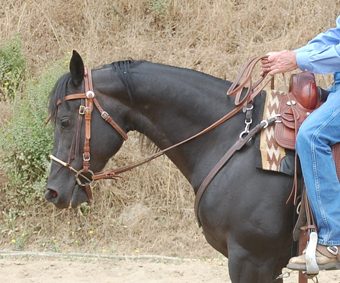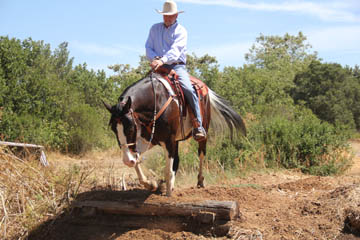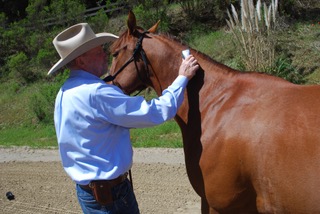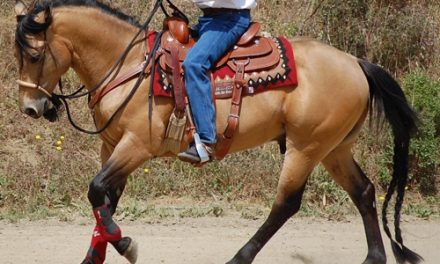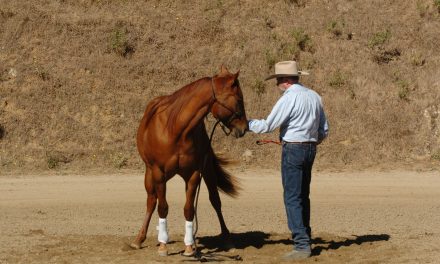
Bend in Elbow
The leg and seat aids are what I call body aids. They work with the reins in communication with the horse. As riders, we want to be balanced on our horses, what I call balanced riders. We want to ride in the center of the horse and we want to stay perpendicular from our ears to our heels. We can shift our weight back to communicate with our horse that we want a change. I am not talking about leaning way back but just moving the shoulders back about one or two inches. This will shift enough of your weight to communicate to your horse.
Many problems I see with riders are related to our natural instinct to lean forward and pull back on the reins. This is particularly true when we ask our horses to go into a canter. When we lean forward and pull back, we shift our weight to the front of the horse. This additional weight has an impact on how the horse is going to respond. Sixty percent of a horse’s weight is naturally on the front end because of the conformation of a horse. A horse can be so fine tuned that a rider lowering his or her chin to look down at the horse as the horse takes a lead can cause the horse to lose rhythm. That additional weight, though very small, can make a big difference in the performance of the horse. When asking for a canter we want to have our weight back on the left seat bone so that the horse will go under himself and come through from the rear.

Good Hand Position
The rein aids show the horse where to go. The inside rein shows the direction and the outside rein reinforces the direction and becomes the supporting rein. The outside rein blocks the shoulder from drifting out. The rider’s leg actually tells the horse where to go. We want our horse trained so that with just light contact, one ounce of pressure with the calf, the horse will respond and move off in the desired direction. If the horse does not respond to one ounce of pressure, we must follow up with additional pressure until the horse responds. I don’t continue to press when a horse fails to move off my leg. I bump with the calf of my leg and I keep bumping and increasing the intensity of the bump until the horse moves. Actually, I use a spur and after a couple of bumps, I tip the spur into the rib cage. The horse will react, moving away from the spur and following its nose. I don’t mean I jab the horse but I put on the pressure required to get the horse to respond. The next time I ask by pressure with my calf, the horse will most likely respond. The problem is that most people are not willing to follow through when a horse fails to respond. If you don’t wear spurs and your horse fails to respond, you can move the shoulder over by tapping with a dressage stick in your right hand.

Big Open Inside Rein
I often hear people say that they do not have enough strength in their legs to give a correct cue. Everyone has enough strength in their legs to apply an ounce of pressure and that is all the pressure that should be required. There are three cue spots on the side of a horse and every horse should know what pressure on these spots means. The Number One spot is directly at the cinch and pressure there tells the horse is to move his shoulder over. The Number Three spot is back toward the rear cinch. Pressure at that spot tells the horse to move his hips over. The Number Two spot, which is between, tells the horse to leg yield or side pass. We must be very thoughtful and consistent with how we position our legs when we press. Sometimes I ask a person in a class or clinic to put a leg on the horse to move the shoulder over. Often I see the rider tightly bend the knee and put their leg on the Number Three spot. Pressure there does not tell the horse to move his shoulder over. You need to be clear and consistent with leg cues or your horse will become confused. You can practice leg cues by sitting on your horse and slightly turning your toe out and putting your calf against the horse at the cinch. This is the Number One spot. Bring your leg back a little bit, say an inch, to get the Number Two spot. For Number three, I straighten my toe to point forward and move my leg slightly back. There are only one or two inches between each spot. It is a matter of becoming familiar with the aids and then being consistent in using them.
Seat aids are very important as well. I often see people riding a circle, going to the left but leaning into the circle. That position puts more pressure on the inside hip which, in turn tells the horse to move away and pushes the circle outward. This is another reason we need to be balanced. Not just front to rear but also right to left. You can practice these things any time someone is around to look at you. See if you are sitting relaxed and centered. Adjust your position if you are leaning back or forward.

Hip Leaning
We need to stay relaxed in the body but sometimes we get tense due to fear. If you are comfortable at a walk and then start to trot, you may become uncomfortable as you start to move faster. You may begin to straighten your legs and stiffen your knees and lower back. When your entire body becomes rigid, you will bounce around and communication with your horse will be lost. We want to be supple and be “one” with the horse. We can’t do that when our bodies are rigid. I encourage people to take pilates. It is not only a great way of exercising but also teaches us to free up individual parts of our bodies. I am surprised how often I see riders try to use a leg and actually use the hip as well because the person is not able to isolate the movement. If I want to pick up a left lead, I just use my left seat. I put weight on my left seat and that tells my horse to shift weight to the left rear engine (hip). The horse is going to want to come through on that side. We can practice shifting our seat weight by sitting on the couch and putting our hands underneath our seat, shifting our weight left, right, back and forth.
We also need to pay attention to what we are doing with our arms and hands. Most people want to ride with their hands up in the air. Our hands should be out in front of the saddle. I tell my clients to keep their hands in a four-inch box in front of the saddle. Hands in front of the saddle normally set a nice soft bend in the elbow. You can’t get a soft feel or get into the rhythm of the horse if your arms are rigid. And, if your arms are straight, you are going to bump the horse in the mouth. We want to stay soft and relaxed in the body. We want to ride from our core which is the lower stomach. This allows us to keep with the rhythm of the horse. Riding this way does not happen over night. Professional lessons may be needed. Have someone take a video of you. It is amazing to see yourself and it is a real education. The more you understand about your body aids and your weight distribution the better communication you will have with your horse.

